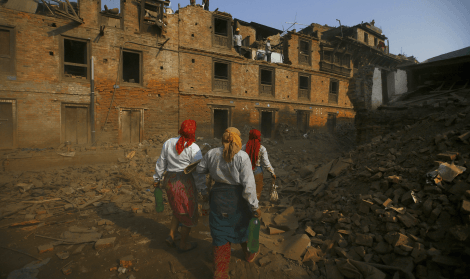On April 25, a massive earthquake in Nepal, and a major aftershock on May 12, killed more than 8,800 people and injured more than 23,000. It was the worst natural disaster to strike this rugged Himalayan nation since a 1934 earthquake. The 2015 quakes triggered deadly landslides and avalanches, flattened entire villages, leveled historic buildings and religious structures, and left hundreds of thousands of people homeless and at the mercy of the elements, with the monsoon season fast approaching.
As news reports of the tragedy started to circulate, the Harvard T.H. Chan School of Public Health—where four Nepalese students are currently enrolled—quickly responded.
- In April, students from the Harvard Chan School, other schools across the Harvard campus, and universities across the U.S. launched Students for Nepal, a coalition to support relief efforts following the Nepal earthquake.
- In early May, a team from the Harvard Humanitarian Initiative arrived in Nepal to assist major nongovernmental organizations, the United Nations, and the Nepalese government with digital data collection, and to observe civil- military engagement in response to the disaster.
- Renee Salas, a part-time MPH student at the Harvard Chan School and an emergency medical physician at Massachusetts General Hospital, was among those who treated injured survivors in several stricken areas of Nepal where she had been working since March, part of a two-year fellowship in wilderness medicine. Salas served with both the Himalayan Rescue Association and the International Medical Corps.
- On May 7, Students for Nepal co-organized a panel discussion on the disaster that was webcast from the Harvard Chan Leadership Studio to hundreds of interested parties. Speakers included Kai Hsiao, MPH ’15, and Jennifer Leaning, François- Xavier Bagnoud Professor of the Practice of Health and Human Rights and director, FXB Center for Health and Human Rights.
- Student Government and other student organizations raised more than $5,700 for Nepalese aid relief by selling eco-friendly aluminum water bottles with the Harvard Chan School logo. Profits were matched by Student Government and went to local Nepali organizations Child Workers in Nepal and Association of Youth Organizations Nepal.
- On June 1, the Nepali ambassador to the United States, Arjun Karki, met with Harvard Chan School students and administrators, as well as students and faculty from other nearby universi- ties, to discuss public health priorities in the devastated nation. “All of us are earthquake victims,” Karki said.
- As the disaster faded from the headlines, Jigyasa Sharma,SD ’18, and others in Students for Nepal published editorials in local and international news outlets to raise awareness of the tremendous unmet needs in the stricken country—from immediate concerns over lack of food and housing to long-term planning for mental health care and health system strengthening.
- Upcoming efforts planned by Students for Nepal include advocating for loan forgiveness for Nepal from international lender organizations, and organizing a symposium to help connect Nepali government and nonprofit representatives with Harvard and other researchers working in the region.
For updates, visit Students for Nepal on Twitter.
Before Nepal Quake: Painting A Picture of Disaster
Before a pair of major earthquakes struck Nepal in spring of 2015, Harvard T.H. Chan School of Public Health student Kai Hsiao, MPH ’15, had described the overwhelming health care needs in the aftermath of such a hypothetical disaster. In a class paper he handed in just weeks before massive quakes on April 25 and May 12, Hsiao portrayed the country’s health care system as unprepared for the triple burden it would face following an earthquake: acute injuries, the threat of potentially epidemic diseases such
as typhoid and cholera, and the needs of large numbers of people with chronic diseases whose care would be disrupted.
An emergency medicine resident originally from New Zealand, Hsiao had spent three months working in a hospital in eastern Nepal before enrolling as a student at the Harvard Chan School in 2014. He noted that emergency medicine is still new in Nepal, with only a handful of physicians trained in the specialty.
Hsiao had researched Nepal’s earthquake preparedness for a course he took earlier this year as part of his concentration in Humani- tarian Studies. He actually learned about this spring’s disaster while participating in a three-day humanitarian response simulation exercise as part of the program. A fellow student working for an aid agency was called to leave the simulation exercise to deploy to Nepal for the actual emergency.
In Hsiao’s predicted scenario, which placed the epicenter of the quake in Kathmandu, deaths and injuries would have been far higher because of the city’s haphazard development and poorly designed buildings.
Presciently, Hsiao stressed the importance of building long-term preparedness and resilience into the humanitarian response to the disaster. “Rather than simply reacting to the immediate needs, how do we leave the place stronger than it was before?”
— Amy Roeder is assistant editor of Harvard Public Heath.
